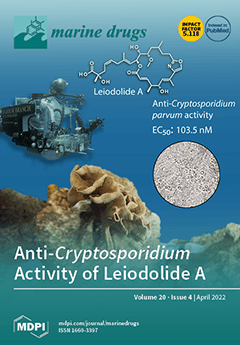A series of twenty-three linear and branched chain mono acetylene lipids were isolated from the Caribbean Sea sponge
Cribrochalina vasculum. Seventeen of the compounds,
1–17, are new, while six,
18–23, were previously characterized from the same sponge. Some of the
[...] Read more.
A series of twenty-three linear and branched chain mono acetylene lipids were isolated from the Caribbean Sea sponge
Cribrochalina vasculum. Seventeen of the compounds,
1–17, are new, while six,
18–23, were previously characterized from the same sponge. Some of the new acetylene-3-hydroxy alkanes
1,
6,
7,
8,
10 were tested for selective cytotoxicity in non-small cell lung carcinoma (NSCLC) cells over WI-38 normal diploid lung fibroblasts. Compound
7, presented clear tumor selective activity while,
1 and
8, showed selectivity at lower doses and
6 and
10, were not active towards NSCLC cells at all. The earlier reported selective cytotoxicity of some acetylene-3-hydroxy alkanes (
scal-18 and
23), in NSCLC cells and/or other tumor cell types were also confirmed for
19,
20 and
22. To further study the structure activity relationships (SAR) of this group of compounds, we synthesized several derivatives of acetylene-3-hydroxy alkanes,
rac-
18,
scal-S-
18,
R-
18,
rac-
27,
rac-
32,
R-
32,
S-
32,
rac-
33,
rac-
41,
rac-
42,
rac-
43,
rac-
45,
rac-
48 and
rac-
49, along with other 3-substituted derivatives,
rac-
35,
rac-
36,
rac-
37,
rac-
38,
rac-
39 and
rac-
40, and assessed their cytotoxic activity against NSCLC cells and diploid fibroblasts. SAR studies revealed that the alcohol moiety at position 3 and its absolute
R configuration both were essential for the tumor cell line selective activity while for its cytotoxic magnitude the alkyl chain length and branching were of less significance.
Full article






